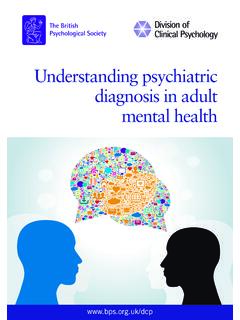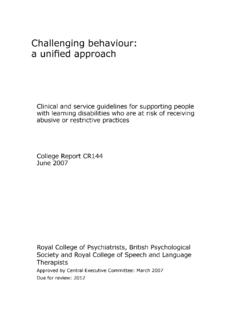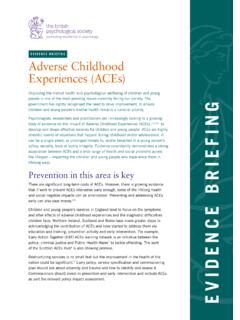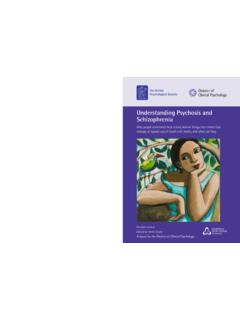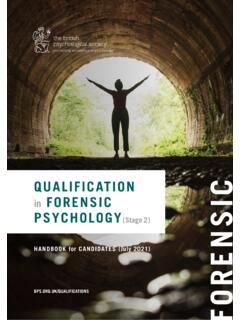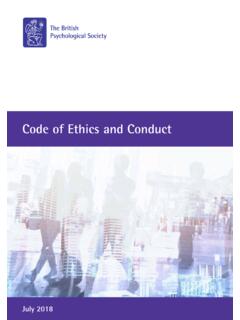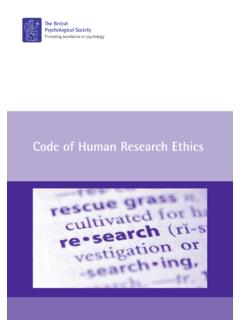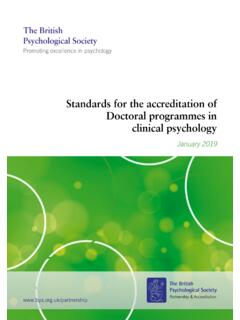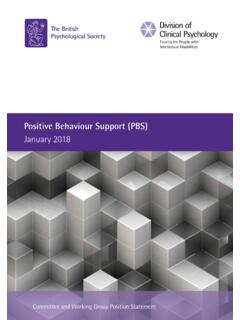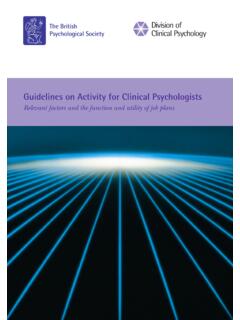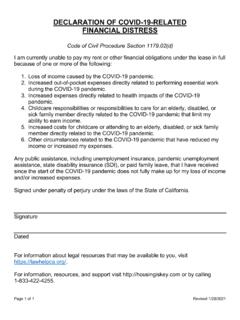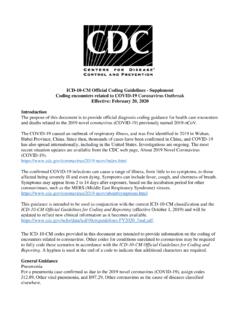Transcription of Covid-related anxiety and distress in the workplace: A ...
1 GUIDANCE. Covid-related anxiety and distress in the workplace: A guide for employers and employees As covid -19 lockdown restrictions are eased, and in some cases temporarily re-introduced, people will experience many different emotional responses to what is happening, whether returning to workplaces after furlough or a period of remote working, or continuing to work in the same setting as they did during lockdown. Each employee will have their own specific concerns regarding their work or personal experience. Feeling worried, concerned or anxious is understandable in a situation that is changing and uncertain. These are common responses and show increased vigilance which helps protect us from harm. How individual employees and employers deal with these feelings can affect their transition into new ways of working, as well as their wellbeing and performance in the immediate and long term.
2 SHARE is a psychologically informed approach developed for this document to help employers and employees deal with Covid-related anxiety and distress and adapt to new ways of working. This document offers practical steps and ideas for creating healthy, GUIDANCE. sustainable working conditions. The five components of SHARE are: 1. SAFE working: Assessing risk in the workplace 2. HELP yourself and others: Communicating and meeting needs. 3. ADAPT to change: Diverse workplace situations and adjusting to the new normal'. 4. RELIEVE the pressure: Helping yourself and others to adapt and cope. 5. EVALUATE: Review the situation regularly to ensure ongoing success Part 1 SHARE Advice for Employers and Employees Part 2 Making the transition to new ways of working: Employer and employee stories COMMON CONCERNS AND FEELINGS. GUIDANCE.
3 Responses will be influenced by a wide range of risk factors including vulnerabilities within the family, change in job roles, threat of redundancy, skill shortages, social networks, and current and previous experience of loss, bereavement, and illness. Feelings are likely to be significantly affected by factors that increase the risks and challenges posed by covid -19 ( being from Black, Asian and Minority Ethnic [BAME] background). FEAR OF EXPOSURE TO covid -19. During the commute to work. At the workplace lack of care over sanitising ( inability to wash hands in hospitality settings or shops after contact with customers' products, glasses, plates, etc), people not maintaining physical distancing, worries about the effectiveness of personal protective equipment (PPE). Bringing the coronavirus home and infecting loved ones, including those who were asked to shield.
4 Becoming ill, and fear of death as a result, particularly for those at increased risk. P S Y C H O L O G I C A L W O R K - R E L AT E D D I S T R E S S. Fears of redundancy, redeployment being laid off or re-furloughed. Moral distress , threats to the individual's purpose and sense of belonging. Changes in work role and practices, and concerns about not having the necessary skills for this. Impact on job performance. Dealing with changing work patterns/shifts, redeployment, loss of control over working routine or locations. Stress because of the effects of the pandemic on existing health conditions and disabilities ( hearing impairment making communication in masks more challenging). Concerns about childcare and other caring responsibilities in a changing environment. Being or feeling unable to challenge unfair or unsafe practices.
5 C O N C E R N S R E L AT E D T O F I N A N C I A L P R E S S U R E S. Employer restructuring to make savings. Organisation going into liquidation/bankruptcy. Cost cutting leading to reduction in training and development opportunities. Reduced hours or loss of overtime resulting in a smaller pay packet. Personal or household debts run up because of lockdown. 2. Covid-related anxiety and distress in the workplace: A guide for employers and employees | BRE40a | OTHER EMOTIONAL REACTIONS. GUIDANCE. Resentment and perceptions of unfairness when people are managed or treated differently. Irritation about colleagues' varying interpretations of risk at home and at work. Frustration/discomfort at having to wear PPE and the effects on job performance. Concerns regarding protection provided at work and managers' interpretation of risk.
6 Stress for managers when balancing employee concerns and organisational pressures. Grief due to bereavement or other losses ( teams, colleagues, or roles). Sadness about returning to the workplace having found pleasure in working from home. Feeling emotionally exhausted, numb, lacking enthusiasm or engagement. Feeling disempowered and that things are out of your control. 3. Covid-related anxiety and distress in the workplace: A guide for employers and employees | BRE40a | GUIDANCE 1. SAFE working: Assessing and managing risk in the workplace As lockdown restrictions change, employers should continue to focus on the safety and wellbeing of their employees. Ensuring that employee wellbeing is prioritised will help to optimise performance. It is in everybody's interest to have a physically and psychologically safe working environment.
7 covid -19 presents unprecedented challenges for safe working and wellbeing. Prioritising employee wellbeing may have short term costs but is likely to optimise performance over the medium to long term. S A F E W O R K I N G W H AT C A N E M P L OY E R S D O ? What are the risks? Use current government guidelines to assess and manage the direct health risks. Consider reviewing your existing stress risk assessment to identify sources of stress and how to manage these. Be aware that these risk factors may change regularly. How to identify individual needs? Understand that everyone's situation is different. Employees have unique concerns and face their own specific challenges, caring for children and relatives, transport issues, disabilities, neurodiversity, experience of illness including long- covid , loss, change. Apply the same return to work process to all employees but allow for different outcomes, some people might continue working from home or remain longer on furlough.
8 How to address issues? Encourage open communication about worries and wellbeing issues. Make it clear that sharing concerns is valued and that it is safe to do so. Recognise that some employees may feel unable to talk openly with managers. Other options include occupational health providers, Employee Assistance Programmes (EAPS), Trade Unions, mental health first aiders, GPs, mental health charities, or informal support from trusted co-workers ( colleagues providing peer support for mental health). Make employees aware of these options. S A F E W O R K I N G W H AT C A N E M P L OY E E S D O ? Are you unsure what is happening? Ask. You can request information about how your employer is following government guidelines on covid -19 risk assessments. Trade Unions, EAPs, mental health charities and GPs can also provide advice.
9 How to get involved? Your organisation will be making changes so that your workplace is safe for you to return. Get involved in consultations about this. Why are there differences? Understand that everyone's situation is different. Some colleagues may need to return to the workplace later or have different hours ( because they have been shielding, have caring responsibilities, or can do their job from home). Are you informed? Identify your needs and your rights and how your employer may meet them. 4. 2020 British Psychological Society BRE36 GUIDANCE. TIPS AND RESOURCES. Risk assessment Stress risk assessment Mind The Samaritans Employee Rights Co-worker Bereavement Working with traumatic material 5. Covid-related anxiety and distress in the workplace: A guide for employers and employees | BRE40a | GUIDANCE 2. HELP yourself and others: Communicating and meeting needs Communication is key to addressing anxiety and distress .
10 Two-way communication about new ways of working will help to reduce uncertainty, distress and ambiguity, and give insight into how to implement supportive measures. H E L P YO U R S E L F A N D O T H E R S W H AT C A N E M P L OY E R S D O ? Are you being proactive? Even if employees appear to be coping, ask them how they are and whether they need additional support. Remember to look out for clues that people are just bearing up', even though they say that everything is ok. Are you helping to find solutions? As an employer, you are in the best position to support your employees. Be flexible in meeting their needs or in finding alternative solutions. Are you communicating enough? Keep people regularly informed about steps to make the workplace covid -19 secure. It is better to repeat and re-present information at times when anxiety is heightened.
